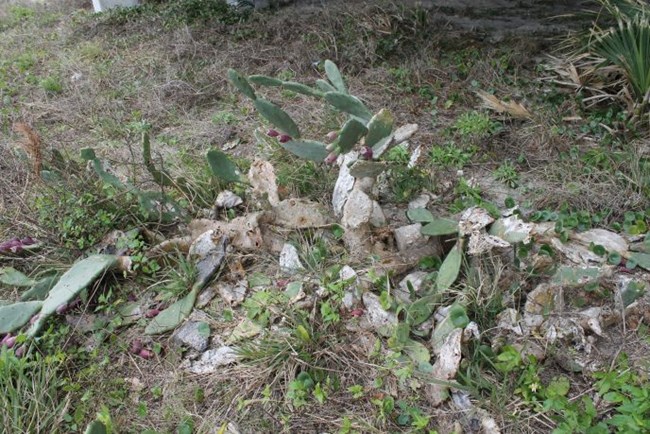
NPS photo A pest can be any animal that causes problems for people, especially when the animal is present in large numbers. Usually the "problem" takes the form of damaged crops and gardens, or a home or other building invaded by pest species looking for food and/or shelter. The class of animals most often associated with pest problems is insects. Common insect pests include: mosquitos, wasps, cockroaches, and ants, all of which are certainly present at Fort Matanzas. (Sometimes way too present, especially mosquitos, which form maddening swarms when weather conditions favor mass hatchings.) But there are three insect species which have caused, or have the potential to cause, significant ecological damage to the park's native plant life. They are the ambrosia beetle, the cactus moth, and the gypsy moth, all non-native invaders of Florida. The ambrosia beetle (Xyleborus glabratus) is native to southeast Asia, and is thought to have arrived in the southeast United States (first detected in Georgia in 2002) as a stowaway on wooden crating material from international cargo. It is the vector for a non-native fungal species called laurel wilt fungus. The beetle carries spores of the fungus in its mouthparts, and when it attacks its preferred host tree, the redbay, the fungus is released into the tree's xylem (the water-conducting sapwood). The multiplying fungus restricts the flow of water throughout the tree's vascular system, resulting in the wilting of the tree's leaves. An infected tree attracts many other ambrosia beetles, which create galleries in the wood, a habitat they use for reproducing and growing more fungi, which is the beetles' food source. The infected tree eventually dies, and the beetles move on to other trees, repeating the process. Since 2006 nearly every redbay tree in Fort Matanzas has been infected. No preventative or curative treatment for laurel wilt disease has been discovered as of yet. The cactus moth (Cactoblastis cactorum) is native to Uruguay, Paraguay, and parts of Argentina and Brazil. It came to the U.S. in a roundabout way from Australia, South Africa, and the Caribbean. It was discovered in Florida in 1989. As its name implies, the cactus moth feeds on cacti, specifically prickly pear cactus, a species native to Florida. The moth has three flight dispersal periods per year, typically April-May, July-August, and October-November. During these times, the moths search out prickly pear pads upon which to alight and lay their eggs. The eggs are laid in a chain-like pattern called an egg stick. The egg sticks resemble and blend in with the spines of the prickly pear pads. There are about 70 eggs per egg stick. When the eggs hatch the small larvae burrow their way into the pad where they grow and feed, eating the cactus from the inside out. Damaged prickly pear pads look white and withered (necrotic). If enough pads are infected the plant will eventually die. Before the larvae mature into moths, they leave the plant and drop to the ground where they will transform and continue the cycle. Each flight period Fort Matanzas staff deploy cactus moth traps (scented sticky traps that lure male moths) supplied by the USDA Animal and Plant Health Inspection Service- Agricultural Research Service, and manually search out and remove egg sticks, in an attempt to mitigate the damage done by these non-native invaders to the park's native cacti. Finally, in May and June of each year, park staff also deploy sticky traps scented with artificial pheromones specific to the gypsy moth. The gypsy moth is a Eurasian species introduced to the northeastern U.S. in 1869. It is a voracious eater of foliage, especially oak species. While this is a pest primarily of the northeastern states, Fort Matanzas participates in a program of the U.S. Forest Service to identify and eliminate outlier gypsy moth infestations wherever they occur. Fortunately, gypsy moths have never been captured in the park. This is one case where null data is welcome data indeed, especially considering the preponderance of live oaks found in this area! |
Last updated: April 14, 2015
